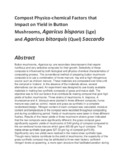| dc.contributor.author | Kariaga, M.G. | |
| dc.contributor.author | Nyongesa, H.W. | |
| dc.contributor.author | Keya, N.C.O. | |
| dc.contributor.author | Tsingalia, H.M. | |
| dc.date.accessioned | 2023-05-19T11:12:16Z | |
| dc.date.available | 2023-05-19T11:12:16Z | |
| dc.date.issued | 2017-08-31 | |
| dc.identifier.uri | https://doi.org/10.1080/09766898.2012.11884685 | |
| dc.identifier.uri | https://www.tandfonline.com/doi/abs/10.1080/09766898.2012.11884685 | |
| dc.identifier.uri | http://ir-library.mmust.ac.ke:8080/xmlui/handle/123456789/2187 | |
| dc.description.abstract | Button mushrooms, Agaricus sp. are secondary decomposers that require nutritious and very selective composts for their growth. Selectivity of these composts is influenced by both biological and physico-chemical characteristics of composting process. The conventional method of preparing button mushroom composts is to use a combination of horse manure, hay and a high nitrogenous source such as chicken manure. These materials are composted over time until the compost is ‘mature’. In the absence of the materials above, several alternatives can be used. An experiment was designed to use locally available materials in making two synthetic composts of grass and maize stalk. The objective was to find out factors that contribute to making compost that give high yields of button mushrooms. Three strains of mushrooms A. bisporus, A. brunescence and A. bitorquis were planted in three different composts; horse manure was used as control, maize and grass as synthetic in a complete randomized design. Nitrogen content of each compost was calculated, moisture content and temperature of the compost were recorded throughout composting and during conditioning period. Yields of mushrooms were taken in three different flushes. Results of the mean yields of three mushroom strains grown indicated that the two composts were significantly different; the grass compost gave significantly superior yields of mushrooms of 549 gm/kg of compost compared to the conventional horse manure which gave 435.66 gm/ kg of compost. The maize straw synthetic type gave 327.33 gm/ kg of compost (pd”0.05). Significantly very low yields were realized in the maize straw synthetic type. Though many factors contribute to the yield of mushrooms, the superiority of the grass synthetic compost may be attributed to three main factors: sufficient nitrogen levels at spawning, a more open structure that facilitated aeration during composting as well as conditioning, and the high temperature regime maintained during composting. Maize straw synthetic compost on the other hand remained soggy due to the spongy stalks which imbibed water readily, especially during steam pasteurization. This resulted in the failure of a temperature build up. Temperature build-up in phase I as well as at peak heating. Moisture content during composting and aeration of the compost heap are significant factors in mushroom compost preparation. | en_US |
| dc.language.iso | en | en_US |
| dc.publisher | Journal of Agricultural Science | en_US |
| dc.subject | Compost, Physico-chemical, Factors, Impact, Yield, Button, Mushrooms, Agaricus, bisporus (Lge), Agaricus, bitorquis (Quel), Saccardo | en_US |
| dc.title | Compost Physico-chemical Factors that Impact on Yield in Button Mushrooms, Agaricus bisporus (Lge) and Agaricus bitorquis (Quel) Saccardo | en_US |
| dc.type | Article | en_US |

